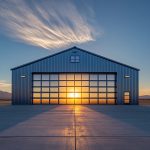How Climate Affects Metal Building Durability and Maintenance

How Climate Affects Metal Building Durability and Maintenance: A Comprehensive Guide
When investing in a metal building, whether for residential, commercial, or industrial purposes, durability is one of the most critical factors.
Metal buildings are renowned for their longevity, low maintenance, and efficiency.
However, one of the most important factors that influence their long-term durability and the frequency of required maintenance is the climate in which they are located.
The various environmental conditions, from extreme heat to intense cold, can significantly affect the structure, integrity, and lifespan of these buildings.
This comprehensive blog will dive into the specific ways climate affects metal building durability and explore the best practices for maintaining these structures based on local environmental conditions.
At Champion Buildings Inc., we understand the importance of building structures that are resilient, long-lasting, and cost-effective.
In this post, we’ll explore how different weather conditions—from freezing winters to sweltering summers—can impact the structural integrity of your metal building and what you can do to maintain it for years to come.
Let’s take a closer look.
The Role of Climate on Metal Buildings
Metal buildings are widely celebrated for their durability and efficiency.
However, as with any building material, the surrounding climate plays a crucial role in determining how well the structure performs over time.
Factors like moisture levels, temperature fluctuations, high winds, heavy snow loads, and even coastal conditions all have an impact on how your metal building will age and require maintenance.
Whether you own a metal commercial building, agricultural facility, or a residential garage, the impact of climate is inevitable.
Understanding the challenges posed by different environmental conditions and being proactive in your maintenance efforts will help you extend the life of your structure and reduce overall repair costs.
How Extreme Climates Affect Metal Buildings
Different weather conditions affect metal buildings in different ways.
Below we’ll break down the impact of extreme temperatures, moisture, snow, and wind.
Rust and Corrosion in Humid or Coastal Areas
One of the most common issues for metal buildings located in coastal areas or places with high humidity is rust and corrosion.
Saltwater, a hallmark of coastal environments, is extremely corrosive.
The salt particles carried by the sea breeze can accelerate the oxidation process, which leads to rust and degradation of the metal surfaces.
In humid climates, even without saltwater exposure, moisture can build up on the surfaces of the metal, which over time can lead to rust formation, weakening the structure.
Regular maintenance is essential in these climates, including the application of corrosion-resistant coatings and timely inspections.
How to Prevent Rust and Corrosion:
Use materials like galvanized steel or stainless steel, which are resistant to corrosion.
Apply protective coatings such as rust inhibitors or marine-grade sealants to your metal surfaces.
Increase ventilation inside the building to reduce moisture buildup.
Regularly clean the exterior surfaces to remove salt and moisture buildup.
Expansion and Contraction Due to Temperature Swings
Another challenge faced by metal buildings is the natural expansion and contraction of the metal material caused by fluctuating temperatures.
Metal expands when heated and contracts when cooled. This cyclical expansion and contraction can place stress on the joints, fasteners, and panels over time.
If the building is not designed to accommodate temperature changes, this stress can cause loose fasteners, warped panels, or even joint failures.
In regions where temperature swings are significant—such as areas with extreme summer heat and freezing winters—this is a concern that must be addressed during the building’s design phase.
How to Manage Temperature Swings:
Use expansion joints and flexible fasteners to allow the building to expand and contract without causing damage.
Opt for high-quality insulation to help regulate interior temperatures and reduce the impact of external temperature changes.
Regularly check fasteners and seals to ensure they are secure and functioning properly.
Snow Load Stress in Colder Regions
In areas where heavy snowfall is common, snow load becomes a significant concern. Snow can accumulate on the roof and other surfaces, placing immense weight on the building structure.
This additional weight can cause roof sagging or even roof collapse if the building is not designed to withstand it.
The risk of snow load stress is highest in colder regions where snow can accumulate over extended periods.
Without proper snow management strategies and design considerations, snow load can lead to serious structural issues.
How to Prevent Snow Load Damage:
Regularly inspect the roof for snow accumulation and remove excess snow before it reaches dangerous levels.
Ensure that the building is designed to handle snow load by consulting with engineers and using appropriate materials and structural reinforcements.
Install heating cables on the roof to melt snow and prevent ice dams from forming.
Wind Damage in Storm-Prone Areas
Wind damage is a major concern for metal buildings located in regions prone to storms, hurricanes, or tornadoes.
High winds can detach panels, tear off roofs, or cause significant structural damage if the building is not properly reinforced.
Wind can also cause debris to collide with the structure, leading to dents or damage to the exterior surfaces.
Proper wind-proofing and reinforcement are critical for buildings located in storm-prone regions.
Without these features, your building could be vulnerable to severe weather events, leading to costly repairs and potential downtime.
How to Prevent Wind Damage:
Install wind-rated anchors and bracing systems that ensure the building remains secure during high winds.
Choose impact-resistant doors and windows to minimize the risk of damage from flying debris.
Conduct regular inspections to ensure all fasteners, panels, and supports are secure and intact.
Best Maintenance Practices for Different Climates
To extend the lifespan of your metal building, maintenance strategies must be tailored to your local climate.
Here are some specific recommendations for maintaining metal buildings in different environmental conditions:
Cold and Snowy Climates
Snow and Ice Management: Regularly check for snow accumulation on the roof and remove excess snow to prevent structural damage.
Snow should be removed promptly after each storm to avoid overloading the roof.
Insulation: Use proper insulation to prevent moisture from condensing inside the building, which can lead to rust and corrosion.
Sealing Gaps: Seal any gaps in the building to prevent ice from forming inside the structure.
Hot and Humid Climates
Corrosion Prevention: Apply corrosion-resistant coatings to all exposed metal surfaces. Regularly inspect and maintain these coatings.
Ventilation: Ensure that there is proper ventilation inside the building to allow for airflow and reduce trapped moisture.
Material Selection: Use stainless steel or galvanized metal in construction to enhance durability and corrosion resistance.
Coastal and Salty Environments
Material Selection: Use aluminum or coated steel to resist salt corrosion.
These materials are more suitable for coastal areas where salt can cause rapid deterioration of metal.
Regular Cleaning: Rinse the exterior surfaces of the building regularly to remove salt buildup, which accelerates rusting.
Protective Sealants: Apply marine-grade protective sealants to prevent corrosion and rust on exposed metal surfaces.
Storm-Prone Areas (Hurricanes, Tornadoes, etc.)
Reinforcements: Install wind-rated anchors and bracing systems to ensure the building is capable of withstanding high winds.
Impact-Resistant Features: Use impact-resistant doors and windows to minimize damage from debris.
Post-Storm Inspections: After major storms, always perform an inspection to identify loose panels, damaged joints, or any structural issues.
Choosing the Right Materials for Longevity
The choice of materials is a significant factor in reducing maintenance costs and ensuring your metal building lasts for decades, no matter the climate.
By selecting the appropriate materials during the design phase, you can ensure your structure stands up to the challenges posed by various environmental conditions.
Galvanized or Stainless Steel: These materials offer excellent resistance to rust and corrosion, ensuring the longevity of your building.
Powder-Coated Finishes: A powder-coated finish provides a protective layer that helps to resist scratches, fading, and environmental wear.
It adds durability and protects the surface from harsh weather conditions.
High-Quality Insulation: Insulated wall panels can help regulate temperature fluctuations, reduce moisture buildup, and improve the overall energy efficiency of the building.
Common Questions About Metal Buildings and Climate
How do I prevent rust in my metal building?
Use galvanized steel or aluminum for rust resistance.
Apply protective coatings to exposed metal and ensure good ventilation to reduce moisture buildup.
Are metal buildings suitable for extreme temperatures?
Yes, with proper insulation and expansion joints, metal buildings can handle extreme temperature variations without compromising structural integrity.
How do metal buildings compare to other materials in varying climates?
Metal buildings tend to outperform materials like wood or concrete, offering superior durability, insulation, and resistance to environmental stressors such as high winds, heavy snow, and temperature fluctuations.
How often should I inspect my metal building?
It is recommended to inspect your metal building at least twice a year, and immediately after any significant weather event or storm, to ensure there are no hidden damages.
Conclusion
Whether you're building a new structure or maintaining an existing one, understanding how climate impacts your metal building is essential to ensuring its longevity.
From snow loads in cold climates to rust in coastal areas, the elements can have a significant effect on your metal building.
However, with the right materials, design, and proactive maintenance, your building can withstand the harshest climates and continue to serve you for many years.




